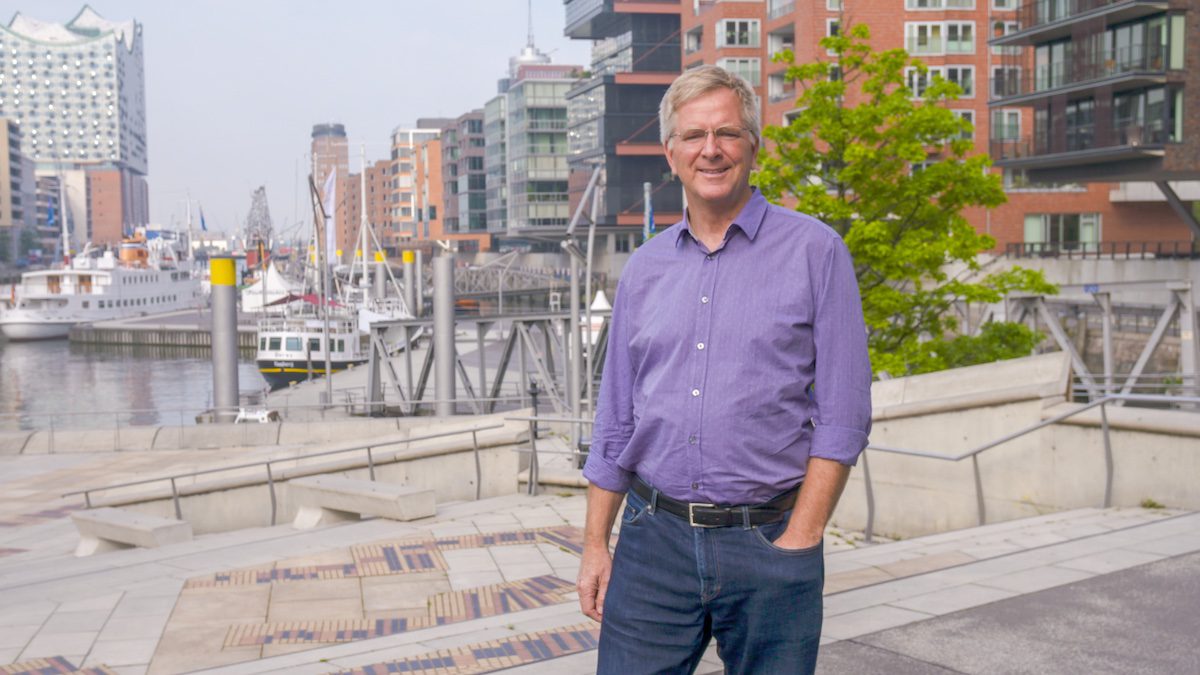Last updated on February 19th, 2024
Featured image: Rick Steves in Porto, a “second city” in Portugal | Phtoto provided by Rick Steves’ Europe
Three Ways to Be a More Thoughtful Traveller
by Carolyn Ray
Rick Steves is one of the most beloved authors in travel, with over 50 European travel books, as well as being the host of public television’s “Rick Steves’ Europe“ and “Travel with Rick Steves.” An advocate for smart, affordable, perspective-broadening travel, Steves encourages people to travel as ‘temporary locals’ and to connect much more intimately and authentically with Europe — and Europeans — for a fraction of what mainstream tourists pay.
On the occasion of JourneyWoman’s 30th anniversary, I spoke with Steves from Palermo, Sicily, near the end of my two-month stay in Europe. In our conversation, we talked about the evolution of women’s solo travel, low season travel and ways that we can all be more thoughtful tourists. It’s hard not to feel inspired after talking with him about Europe, which he says has returned to travel with ‘gusto’, something I’ve experienced on my recent travels through France, Belgium, Italy and Malta.
Tourism in Europe has rebounded
Steves says: “People told me, ‘After the pandemic, nobody is going to be kissing cheeks in Paris anymore’. Well, they’re kissing cheeks with gusto, almost like they’re making up for lost time. So that’s all really good news.”
“Europe is the springboard — and the wading pool — for world travel,” he says. “I was afraid that all the little mom-and-pop shops that carbonate the experience would go out of business during COVID. But they survived remarkably well. And now, everybody’s making up for lost time and it’s busier than ever.”
Indeed, European travel hit new milestones in 2023, almost returning to pre-pandemic levels. According to the latest data from the World Tourism Organization (UNWTO), Europe, the world’s most visited region, reached 94% of 2019 levels, with France, Spain and Turkey being the most visited countries in 2023. In 2024, more growth is expected in Europe as Romania and Bulgaria join the Schengen region in March 2024, and with Paris hosting the Summer Olympics in July and August. According to the US National Travel and Tourism Office (NTTO), US travel to Europe represents 21% of total US overseas travel.
So, is all this travel to Europe a good thing?
“The world would be a better place if we all travelled,” Steves says. “Travelling lets the world know each other. If we want a safer, more stable world, we’ve got to get out there and get to know the other 96% of humanity – especially Americans. That’s a beautiful, powerful thing.”
“I want to get Americans out there to get to know the world. If every American had to travel before we voted, we’d have a different political attitude.” — Rick Steves
Three ways to be more thoughtful travellers
As we look at the way we travel, there are many ways that we can have more authentic and meaningful travel experiences. But it all starts with making human connections.
“For me, the mark of a good traveller is how you meet the local people,” Steves says. “When you do the local things, you see culture shock as not something to avoid but something to embrace as a constructive thing. The growing pains are signs of a broadening perspective.”
What can we do to be more thoughtful travellers?
1. Stop following the crowd
Steves says many people are crowdsourcing travel advice, which ultimately leads to everyone going to the same place at the same time.
“Everybody is hellbent on going to the exact same space to get their social media photograph, right there on that pier with that mountain behind them,” he says. “It’s odd. I know nothing about that – it’s not my thing is to go over there and take a selfie of me and put it on social media just to celebrate where I went. But I see that happening and it just kind of befuddles me because a lot of those people don’t even know where they are, or why they’re there. It’s just that’s where you’re supposed to go.”
“It’s a growing issue in Europe,” he says.” And it puts everybody in the same place at the same time, complaining about the same crowds. Europe is not insurmountably crowded. If you want to go where everybody else wants to go and you do it during peak times, there’s the problem. So that’s an issue.”
Read More: 30 Less-Travelled Places for Women in 2024

Rick Steves with stacks of his beloved European guidebooks / Photo provided by Rick Steves’ Europe
2. Look at the low season as an alternative
“If you go in the off-season, you step in and it’s just you and the guard and a couple of people,” Steves says. “At the Pantheon, it makes all the difference in the world. Europeans like to tell me there’s no bad weather, just inappropriate clothing. So more and more, I’m thinking of off-season. There are two kinds of travellers, those who wait in lines and those who don’t wait in lines. And those who want to avoid the lines can do it.”
As I’ve discovered in my three months travelling in Italy during the low season, there are virtually no lineups and very few tourists at monuments, museums and towns that are typically over touristed in the peak season.
“If you’re going to bombard Dubrovnik in July in the middle of the day and there’s three cruise ships in the port, you’re going to be with 6,000 travellers,” he says. “Don’t blame the local people for just hunkering down and grabbing your money. You’ve taken over their beautiful city and they’re just smiling because they want your money. If you go in the offseason, they’re smiling because they’d like to buy you a beer and get to know you.”
3. Discover ‘second cities’
For those who want to travel in the low season in Europe, Steves recommends larger cities but also suggests what he calls ‘second cities.’
“I love going to the stately places where you celebrate what they were yesterday,” he says. “But to see what’s going on today, that would be what I call the second cities.”
According to Steves, second cities have a lot of creative edge, beautiful street art and little foodie holes in the wall that cater to locals, not tourists. Some of his examples include Porto, Glasgow, Belfast and Marseilles.
“These second cities are feisty,” he says. “Going there will save you money. You’ll be away from any crowds. And you’ll be feeling the pulse of that country today. Every place in Europe has sort of a rough working class, industrial rust-belt kind of city that right now is energetic, and coming back with gusto.”
One of my favourite ‘second cities’ is Bristol, which Steves says is a perfect example.
“All my life I’ve been going to Bath — and I love Bath,” he says. “But a half an hour beyond Bath is Bristol. Go to Bristol and you got yourself the equivalent of Glasgow, Liverpool or Belfast.”

Rick Steves in Hamburg, a “second-city” in Germany / Photo provided by Rick Steves’ Europe
Looking Ahead: Time and money will be even more precious
At the end of the day, Steves says time and money are precious commodities for all travellers, but particularly independent travellers.
“When we started out it was Europe on $5 a day, taking care of your money,” Steves says. “My first books were, “2 to 22 Days in Germany, Austria, and Switzerland” and “2 to 22 Days in Spain and Portugal”. We have to use our time and our money smartly so we can have rich experiences.”
When it comes to solo female travel, Steves is an enthusiastic fan.
“Independent travel offers the opportunity to have more interesting experiences,” he says. “You’re more approachable, and you’re more interested in not having a table where they leave you alone, but sitting at the bar where people want to talk to you.”
And if you’re wondering who Steve credits for his start in travel? His mom, June Steves.
“Even though my mom, June Steves, passed away in 2011, she remains a huge presence in my life,” he wrote in a Mother’s Day post on Facebook in 2021. “It was my mom who first took me to Europe, catapulting me into the wonderful life I’ve enjoyed. Mom was my first travel partner. I have a hunch my mom knew she had helped plant a seed in me that would sprout into a lifelong passion for travel.“

Rick and his mom, June Steves, 40, at SeaTac Airport en route to Copenhagen / Photo provided by Rick Steves’ Europe
More Stories From Less-Traveled Places
Curious Where Travel Writers Spend the Holidays? Less-Travelled Places to Add to Your List
Have you ever wondered where travel writers spend the holidays? The JourneyWoman writing team shares less-travelled places to add to your list.
Women Are Keeping Traditions Alive in Chihuahua, Mexico
Featured image: The stunning Copper Canyon (Barrancas del Cobre), has a gulf four times bigger than the Grand Canyon | Photo by wirestock on EnvatoChihuahua has some of Mexico's most spectacular natural formations by Kathy Buckworth At the age of 61, I was excited to...
Hidden Gems and Small Villages for Women to Explore Near Mexico City
Vibrant villages in Ixtapan de la Sal, Tecometepec, Taxco, Toluca and Metepec offer women travellers a deeper connection to Mexico.







How wonderful that you had a conversation with Rick and how delightful that he is supportive of solo travel and women’s travel and all the good things Journeywoman stands for.
I love Rick Steves Europe. Me and 2 of my boys watch an episode every Sunday morning. But sometimes it is a little frustrating reading about not going during peak season and why some people would do that. The reality is, with four kids in school it’s really hard to not go during peak season.
Of course it’s not for everyone, but it’s much more cost effective to travel in the low season.